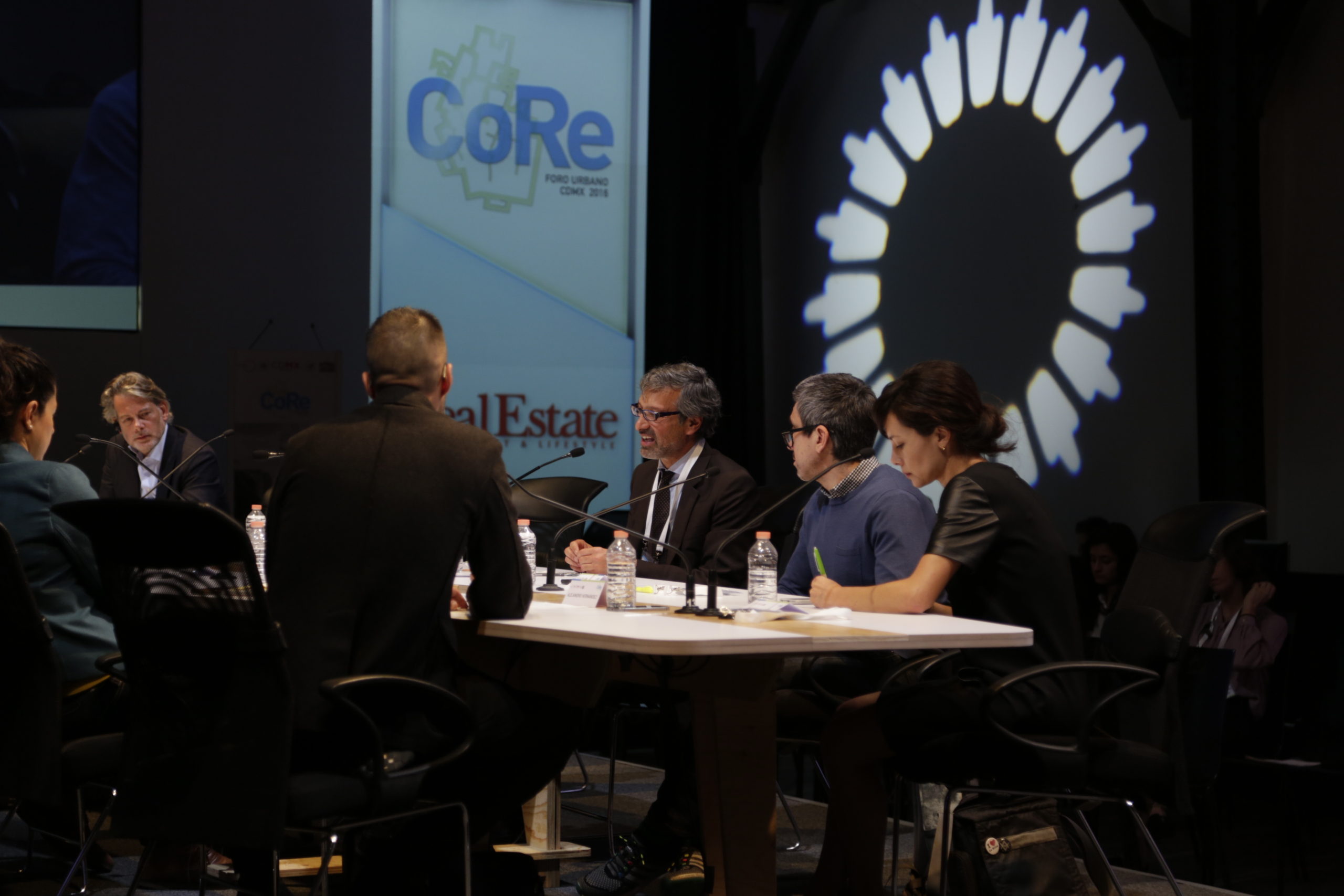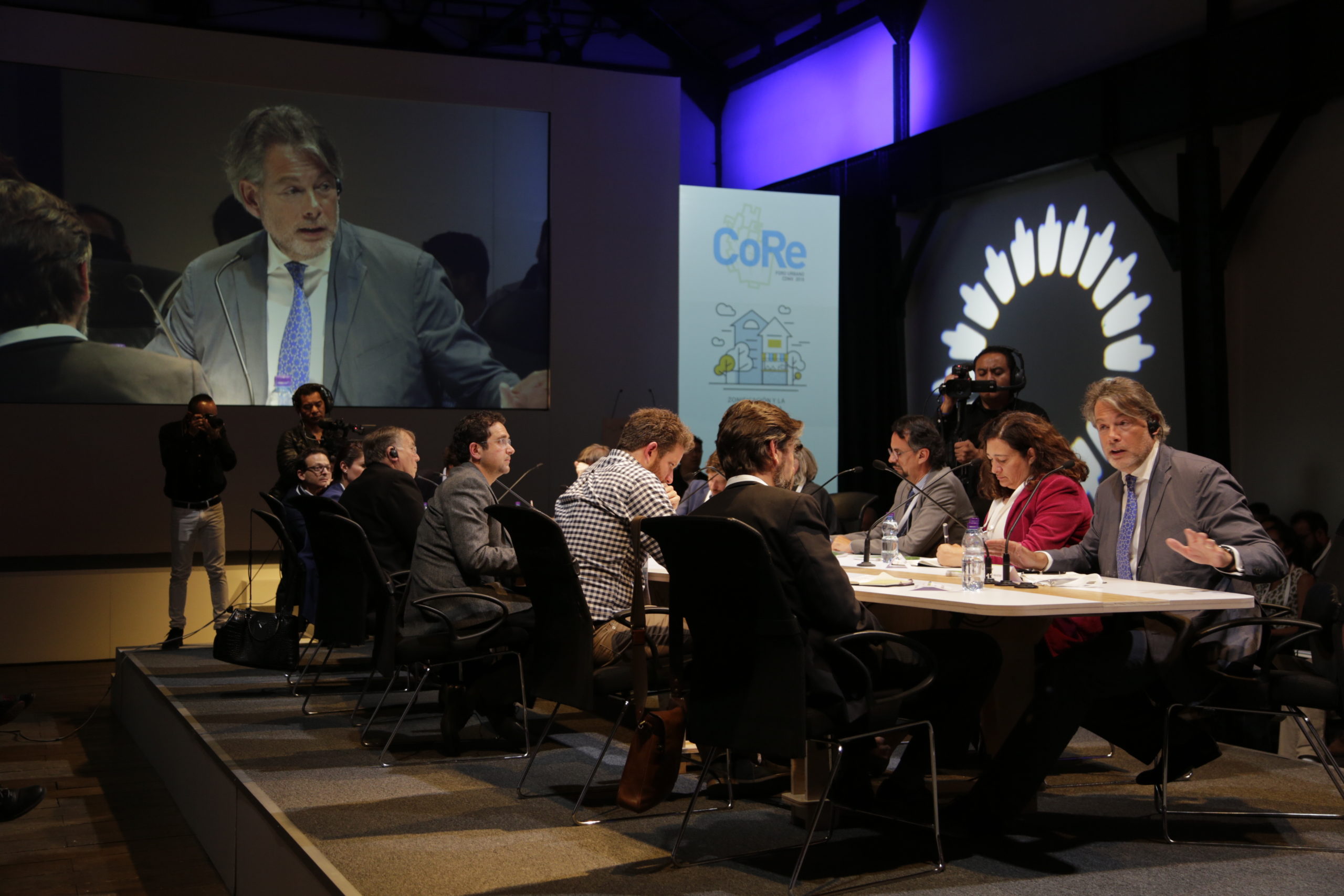MÁS CIUDAD, MENOS CAJONES DE ESTACIONAMIENTOS, PRINCIPAL LLAMADO EN EL MARCO
DE CoRe FORO URBANO DE LA CIUDAD DE MÉXICO
- 5.5 millones de autos circulan en la Ciudad de México
- 400 vehículos por cada 100 mil habitantes
- Invertir en un sistema de transporte digno requeriría por lo menos 30 mil millones de pesos al año
- 76% del presupuesto federal se destina a infraestructura para el automóvil
Ciudad de México, a 7 de diciembre del 2106.- En el marco de los trabajos de CoRe Foro Urbano CDMX 2016 que dieron inicio el día de hoy, el principal mensaje emitido por los integrantes de las mesas de análisis fue: “Más ciudad y menos cajones de estacionamiento”.
Actualmente, circulan en la Ciudad de México 5.5 millones de autos, esto equivale a 400 vehículos por cada 100 mil habitantes, por ello es importante invertir en un sistema de transporte digno para lo cual anualmente se requeriría invertir al menos 30 mil millones de pesos anualmente, pero contrario a esto, el 76% del presupuesto federal se destina a infraestructura para el automóvil.
CoRe Foro Urbano CDMX 2016 es un espacio en donde un grupo multidisciplinario integrado por empresarios, académicos, ciudadanos, servidores públicos, arquitectos y urbanistas nacionales e internacionales se dieron cita para debatir en la búsqueda de las mejores soluciones sobre el futuro de la Ciudad de México que se encuentra rebasada en términos económicos y demográficos.
Durante la puesta en marcha de los trabajos, Antonio del Valle Perochena, presidente del Consejo de Administración del Grupo Empresarial Kaluz, convocó a los asistentes a ver la Ciudad de México desde dos visiones, haciendo clara alusión a la obra de Charles Dickens Historia de dos Ciudades. La primera visión que sugirió fue la de una ciudad colapsada por el tráfico y el estrés, y otra ciudad en la que no se tenga que utilizar el automóvil porque los servicios quedan a no más de 5 kilómetros de distancia y con buenos espacios públicos, “éstas son las dos opciones que tenemos hoy para pensar a la Ciudad de México”, remató el directivo de Grupo Kaluz.
Bajo cuatro ejes temáticos, Movilidad, Espacio Público, Zonificación y la ciudad diversa, y Participación Ciudadana, CoRe trabajó en esta primera sesión en los paneles de Movilidad y Espacio Público.
En el primero de ellos, los trabajos fueron encabezados por Camila Ween y Jan Gehl, y se contó con la participación de Laura Ballesteros, Rodrigo Díaz, Edgar Farah, Onésimo Flores, Javier Hidalgo, Michael Kodransky, Ulises Navarro, Andrés Sañudo y Florencia Serrania.
Este grupo abordó el tema de la movilidad en las grandes ciudades, y para analizar la problemática que al respecto tenemos, ya que en el futuro inmediato se determinaron tres ejes que se deben atender: integrar el desarrollo urbano con el transporte público, lo cual ha sido un aspecto descuidado; lograr tener más opciones de movilidad de calidad, sobre todo en el transporte público masivo (por ejemplo, muchos se jactan de usar el Metro en Londres o Nueva York pero se ve con cierto desprecio en México); y seguir insistiendo en la búsqueda de opciones que sustituyan el uso del automóvil.
Los participantes coincidieron en que México no es tan distinto a otras ciudades, lo cual quiere decir que las consecuencias que tiene el auto sobre los seres humanos son tan aterradoras aquí como en todos los rincones del planeta. Aseguraron que los combustibles fósiles nos están matando. Por ello, se requiere de un plan de acción para que esta ciudad y este planeta sean más saludable; encontrar ideas concretas para que tengamos la oportunidad de vivir en ciudades realmente hermosas.
Durante la segunda mesa, Espacio Público, encabezada por Jose Castillo, curador de CoRe Foro Urbano, participaron la Secretaria de Medio Ambiente Tanya Muller Ethan Kent y Camilla van Deurs, además de Tatiana Bilbao, Guillermo Buitano, Aliza Chelminski, Lili Haua, Belinda Tato, Roberto Remes y Alberto Martínez.
En este panel, los participantes coincidieron en que los espacios públicos deben antes que nada ser incluyentes, lo que implica que se dé espacio y cohesión y en especial en el corredor Reforma, a los habitantes, personas que trabajan, visitantes, y comerciantes.
Finalmente, durante los trabajos de esta primera jornada, se presentó el libro “Ciudades para la gente” del arquitecto y experto en diseño urbano, Jan Gehl, socio fundador de Gehl Architects y considerado uno de los gurús más prominentes del diseño urbano en la actualidad, con más de cincuenta años contemplando el desarrollo urbano. Por medio siglo, Gehl ha invertido buena parte de su tiempo y vocación en reinventar ciudades para que integren las nuevas necesidades de las sociedades modernas. Su participación ha sido decisiva en el rediseño urbano de ciudades como Copenhague, Nueva York, Moscú, Sao Paulo o Singapur.
________________________________________________________________—–
Acerca de CoRe Foro Urbano
El foro está conformado por un grupo de ciudadanos (empresarios, académicos, ciudadanos, servidores públicos, arquitectos y urbanistas), con una visión sobre el futuro de la Ciudad de México, y convencidos del gran potencial que tiene nuestra Ciudad. Pasamos hoy por un momento histórico en el que podemos redefinir el futuro, con miras a una ciudad que potencia al máximo todas sus cualidades y se redefina buscando calidad de vida para sus ciudadanos y sus visitantes. Buscamos hacer ciudad a través de cuatro temas fundamentales para crear conciencia y consenso para llegar a tener la ciudad que todos queremos
Contacto para prensa
Francisco Galindo/ Pedro Suárez y Gerson Hernández
fgalindo@zimat.com.mx
psuarez@zimat.com.mx
ghernadez@cepol.com.mx
MÁS CIUDAD, MENOS CAJONES DE ESTACIONAMIENTOS, PRINCIPAL LLAMADO EN EL MARCO
DE CoRe FORO URBANO DE LA CIUDAD DE MÉXICO
- 5.5 millones de autos circulan en la Ciudad de México
- 400 vehículos por cada 100 mil habitantes
- Invertir en un sistema de transporte digno requeriría por lo menos 30 mil millones de pesos al año
- 76% del presupuesto federal se destina a infraestructura para el automóvil
Ciudad de México, a 7 de diciembre del 2106.- En el marco de los trabajos de CoRe Foro Urbano CDMX 2016 que dieron inicio el día de hoy, el principal mensaje emitido por los integrantes de las mesas de análisis fue: “Más ciudad y menos cajones de estacionamiento”.
Actualmente, circulan en la Ciudad de México 5.5 millones de autos, esto equivale a 400 vehículos por cada 100 mil habitantes, por ello es importante invertir en un sistema de transporte digno para lo cual anualmente se requeriría invertir al menos 30 mil millones de pesos anualmente, pero contrario a esto, el 76% del presupuesto federal se destina a infraestructura para el automóvil.
CoRe Foro Urbano CDMX 2016 es un espacio en donde un grupo multidisciplinario integrado por empresarios, académicos, ciudadanos, servidores públicos, arquitectos y urbanistas nacionales e internacionales se dieron cita para debatir en la búsqueda de las mejores soluciones sobre el futuro de la Ciudad de México que se encuentra rebasada en términos económicos y demográficos.
Durante la puesta en marcha de los trabajos, Antonio del Valle Perochena, presidente del Consejo de Administración del Grupo Empresarial Kaluz, convocó a los asistentes a ver la Ciudad de México desde dos visiones, haciendo clara alusión a la obra de Charles Dickens Historia de dos Ciudades. La primera visión que sugirió fue la de una ciudad colapsada por el tráfico y el estrés, y otra ciudad en la que no se tenga que utilizar el automóvil porque los servicios quedan a no más de 5 kilómetros de distancia y con buenos espacios públicos, “éstas son las dos opciones que tenemos hoy para pensar a la Ciudad de México”, remató el directivo de Grupo Kaluz.
Bajo cuatro ejes temáticos, Movilidad, Espacio Público, Zonificación y la ciudad diversa, y Participación Ciudadana, CoRe trabajó en esta primera sesión en los paneles de Movilidad y Espacio Público.
En el primero de ellos, los trabajos fueron encabezados por Camila Ween y Jan Gehl, y se contó con la participación de Laura Ballesteros, Rodrigo Díaz, Edgar Farah, Onésimo Flores, Javier Hidalgo, Michael Kodransky, Ulises Navarro, Andrés Sañudo y Florencia Serrania.
Este grupo abordó el tema de la movilidad en las grandes ciudades, y para analizar la problemática que al respecto tenemos, ya que en el futuro inmediato se determinaron tres ejes que se deben atender: integrar el desarrollo urbano con el transporte público, lo cual ha sido un aspecto descuidado; lograr tener más opciones de movilidad de calidad, sobre todo en el transporte público masivo (por ejemplo, muchos se jactan de usar el Metro en Londres o Nueva York pero se ve con cierto desprecio en México); y seguir insistiendo en la búsqueda de opciones que sustituyan el uso del automóvil.
Los participantes coincidieron en que México no es tan distinto a otras ciudades, lo cual quiere decir que las consecuencias que tiene el auto sobre los seres humanos son tan aterradoras aquí como en todos los rincones del planeta. Aseguraron que los combustibles fósiles nos están matando. Por ello, se requiere de un plan de acción para que esta ciudad y este planeta sean más saludable; encontrar ideas concretas para que tengamos la oportunidad de vivir en ciudades realmente hermosas.
Durante la segunda mesa, Espacio Público, encabezada por Jose Castillo, curador de CoRe Foro Urbano, participaron la Secretaria de Medio Ambiente Tanya Muller Ethan Kent y Camilla van Deurs, además de Tatiana Bilbao, Guillermo Buitano, Aliza Chelminski, Lili Haua, Belinda Tato, Roberto Remes y Alberto Martínez.
En este panel, los participantes coincidieron en que los espacios públicos deben antes que nada ser incluyentes, lo que implica que se dé espacio y cohesión y en especial en el corredor Reforma, a los habitantes, personas que trabajan, visitantes, y comerciantes.
Finalmente, durante los trabajos de esta primera jornada, se presentó el libro “Ciudades para la gente” del arquitecto y experto en diseño urbano, Jan Gehl, socio fundador de Gehl Architects y considerado uno de los gurús más prominentes del diseño urbano en la actualidad, con más de cincuenta años contemplando el desarrollo urbano. Por medio siglo, Gehl ha invertido buena parte de su tiempo y vocación en reinventar ciudades para que integren las nuevas necesidades de las sociedades modernas. Su participación ha sido decisiva en el rediseño urbano de ciudades como Copenhague, Nueva York, Moscú, Sao Paulo o Singapur.
________________________________________________________________—–
Acerca de CoRe Foro Urbano
El foro está conformado por un grupo de ciudadanos (empresarios, académicos, ciudadanos, servidores públicos, arquitectos y urbanistas), con una visión sobre el futuro de la Ciudad de México, y convencidos del gran potencial que tiene nuestra Ciudad. Pasamos hoy por un momento histórico en el que podemos redefinir el futuro, con miras a una ciudad que potencia al máximo todas sus cualidades y se redefina buscando calidad de vida para sus ciudadanos y sus visitantes. Buscamos hacer ciudad a través de cuatro temas fundamentales para crear conciencia y consenso para llegar a tener la ciudad que todos queremos
Contacto para prensa
Francisco Galindo/ Pedro Suárez y Gerson Hernández
fgalindo@zimat.com.mx
psuarez@zimat.com.mx
ghernadez@cepol.com.mx






